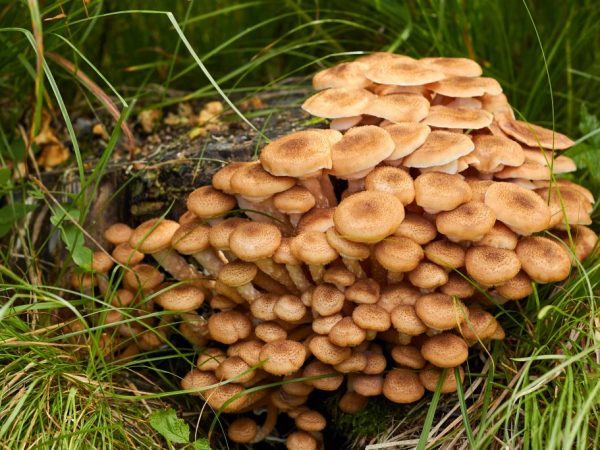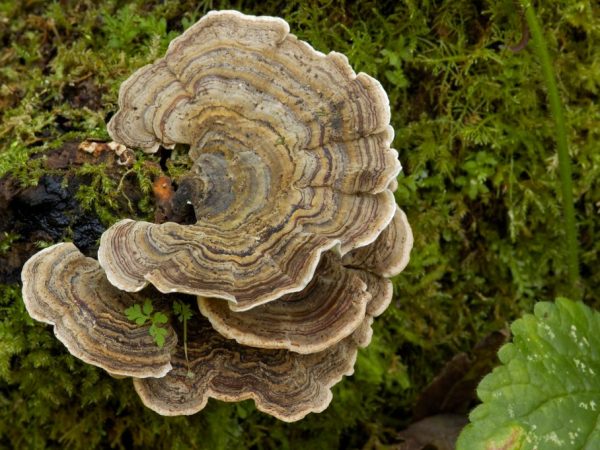Mushrooms on stumps
Mushrooms on stumps "let" mycelium into the thickness of the tree tissue, and some grow on rotten trees. There are edible and poisonous "hemp" species.

Mushrooms on stumps
Honey mushrooms
These stump-growing mushrooms are the most famous. Every mushroom picker knows their name and will distinguish them by their characteristic appearance. Description:
- A small white or yellowish cap. These mushrooms are brown.
- The leg is long, irregular in shape, expanding towards the place of attachment to the substrate (but this is not swelling!).
- The pulp is firm, with a pleasant smell.
- They grow in groups. The conglomerate consists of separate individuals, on one stump there are up to 4 groups of 8-10 pcs.
They grow in all climatic zones. There are spring species, they begin to bear fruit in May.
There are also autumn, winter, which grow to the first snow near the trees. Winter honey fungus is the only species capable of freezing for the winter and growing further during the thaw.
The color of the specimen depends on the location:
- Mushrooms on mulberry, poplar, and acacia acquire a honey-yellow hue.
- Brown grows on oak.
- Dark gray - on elderberry.
- Red-brown - on conifers.
Poisonous doubles: pale toadstool, false mushrooms.
Oyster mushrooms
This is the name of the type of mushroom that grows on the trunks of dead trees or on stumps.
At home and in production, stumps are replaced with sawdust, cotton wool, straw. Description of the species: fruiting bodies in the form of petals or ears of various shades: from white to grayish.
The fruiting season is from late September to November. Oyster mushrooms grown on a substrate in bags are able to begin to rot, so mushroom pickers are advised to use glass containers. Also, the species is called "oyster mushroom" and is widely used in cooking not only in Russia, but also in Asia and America.
Poisonous twins: there are none in temperate latitudes; Orange oyster mushroom, which grows on rotten stumps, is considered inedible.
Tiger saw-leaf
This is a wood-destroying species. If the mushrooms have grown on a living plant, then soon it will collapse and die.
By description, they are similar to porcini mushrooms, which bear fruit in May. The color of the cap matches the color of the white champignon. Features of sawfoot:
- Its cap tapers downwards, like an inverted umbrella, merges with the leg.
- In the middle of the cap there is a depression, like in chanterelles.
- The edges of the cap are wavy.
Its synonym "brindle" was named because of its color: dark gray stripes stand out on white. The species has no poisonous counterparts, but it itself has a low nutritional value. The first specimens appear in May; fruiting ends in November.
It is recommended to eat only boiled caps of young individuals, because their legs are harsh.
Tinder

Tinder shape resembles an ear
The fruiting body is characterized by its external variability. Different species can be very different in structure from ordinary mushrooms. For example, the type of changeable tinder fungus resembles a saw-leaf in structure, and the smoky one looks like a washer. One name unites completely different species.
Irina Selyutina (Biologist):
Tinder fungi, like honey mushrooms, are a non-systematic group of mushrooms. Usually, tinder fungi are called all mushrooms that develop on wood and very rarely on soil and are characterized by the following features in the external structure:
- fruiting body: prostrate, sessile or cap-pectoral;
- hymenophore: tubular;
- pulp: can be both fleshy and tough in consistency (leathery, corky, woody).
Already at the end of the 19th century, the group, which was considered systematic and the fungi were separated into a separate family Polyporaceae, was recognized as artificial. But until the middle of the 20th century, it was preserved in systematics.
The edible species is sulfur-yellow tinder fungus. It is attached by the fruiting body to the bark of a tree or stump; the body and leg are not distinguished. The mushroom bodies are shaped like ears or wavy petals. Young mushrooms are eaten after boiling. Individuals on conifers are bypassed, they are poisonous to humans. The species affects the following trees:
- poplar;
- cedar;
- pine;
- maple;
- birch;
- nut;
- chestnut;
- fruit trees;
- oak;
- willow;
- linden;
- larch;
- less often spruce.
Also, representatives of this species are used in Russia and China for medicinal purposes for the preparation of tinctures, ointments, powders.
Cultivating at home
Growing mushrooms at home on stumps is carried out with two goals:
- Utilitarian: edible is used for eating. So whole mushroom plantations are bred in the basement or in the garden.
- Decorative: decorating fruit trees or gardens. People decorate the dacha with bright fruit bodies: some types of tinder fungus are suitable for such purposes.
The search for suitable stumps is carried out in the forest or dried trees are cut. Some species take root equally well on all types of wood, while others are more demanding on the substrate. Growing on a large scale requires the following:
- Suitable place for sowing, high quality mycelium.
- Temperature and light conditions.
- Regular treatment and replacement of stumps or other substrate. Fruit bodies completely destroy wood in 6-8 years.
If the mushrooms have grown on their own plot, then they will be tasty, environmentally friendly, with healing properties.
Conclusion
Many mushrooms grow on stumps, which makes it possible to grow them at home and in production. Honey mushroom is a delicious and edible forest species. Saw-leaf, oyster mushroom, tinder fungus differ in taste, but with proper heat treatment, they are no worse than white or champignons. Do not confuse them with poisonous toadstools or inedible relatives, but for this you need to know their distinctive features.


